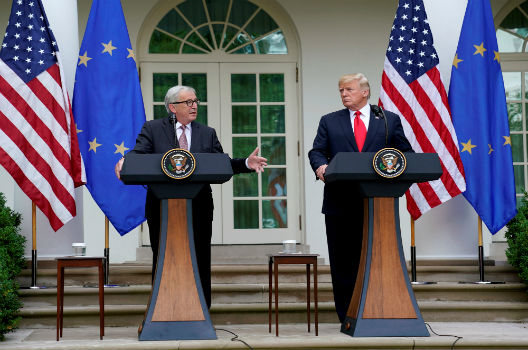Most encouraging about President Trump’s trade deal with the European Union this week wasn’t the escalating conflict it defused but rather the historic possibility it opened.
While President Trump had been applying new aluminum and steel tariffs to allies, triggering retaliatory measures against everything from US agricultural products to Harley Davidson motorcycles, China had been rapidly advancing what its leader Xi Jinping immodestly has called “the project of the century.”
This vast economic effort has been confusingly labelled the Belt and Road Initiative, or BRI. Over time it has expanded from an effort to replicate history’s regional Silk Road to something far more global and ambitious, with growing security and geopolitical consequences. The Economist’s cover this weekend translated BRI into more understandable English: “Planet China.”
Estimates of the total investments in this project, aimed at connecting the world around Beijing’s influence, range from $1 to $8 trillion. Hard as that figure is to calculate, even more difficult to know is how the effort over time will reshape the global order of rules and institutions designed by the US and its friends after World War II. The fact that Chinese experts themselves compare the project to the era-shaping U.S. Marshall Plan after World War II—except far bigger and with more global reach—provides the context for our times.
That’s why Inflection Points has been tracking, with concern, the fraying of democracies – amid populism and nationalism – and the recently growing trade divisions between the US and its allies, at a time when they should be more cohesively addressing China’s advance and its unfair trade practices.
And that’s why the news of the past week is of such potential importance.
Within a short week, the worst transatlantic conflict in recent memory may have been transformed, if now managed intelligently, into what could become the most significant geopolitical and geo-economic achievement of the Trump administration.
EU Commission President Jean-Claude Juncker flew to town with the minimum hope of heading off new auto tariffs and the worsening of the ongoing transatlantic trade conflict. He left with an agreement that the world’s most important community of democracies would work towards creating the most robust global economic zone of “zero tariffs, zero non-tariff barriers and zero subsidies on non-auto industrial goods.”
White House insiders say what helped sway President Trump this week into a deal-making mood was the European willingness to buy more American Liquified Natural Gas and soybeans. Beyond that, the economic and political backlash from his trade policies were growing clearer in a week when retaliatory measures from US trade partners had so badly hurt American farmers that the administration had approved $12 billion in subsidies to heal the wounds.
Going into this November’s mid-term elections, President Trump’s most compelling campaign argument on behalf of Republicans is the economic and job growth his tax cuts and deregulatory policies have generated, resulting in a head-turning 4.1% growth in the second quarter. White House advisors have increasingly worried that trade disputes might undermine that narrative. This week was an indication the President may now agree.
The electoral consequences will be considerable, but it is the global stakes that should motivate Trump most. We face a defining moment in history that will determine which country or group of countries shapes the future. The Economist rightly sees the balance of risks and benefits of China’s Belt Road Initiative as directly related to US engagement in Asia, economically and militarily.
“If the United States is engaged, the world can mitigate the dangers of BRI and reap its rewards,” the Economist correctly observes. “If not, the risks will outweigh the benefits.”
On that score, the US withdrawal from the Trans-Pacific Partnership (TPP) in the first hours of the Trump administration was a strategic blunder. The harm has been reduced by Japan’s decision to push forward and close the agreement earlier this year with the ten other countries involved.
Now that the Trump has reached a truce on trade with Europe, with the chance of forging a new agreement, it may also be a good time to revisit how the US could rejoin the TPP. Japan has opened that possibility by leaving twenty or more portions of the agreement, of greatest interest to the US, frozen and awaiting the sort of deal-making President Trump showed this week.
Frederick Kempe is president and chief executive officer of the Atlantic Council. You can follow him on Twitter @FredKempe. This blog post is based on his weekly InflectionPoints newsletter. Read the newsletter in full here.
Image: U.S. President Donald Trump and President of the European Commission Jean-Claude Juncker speak about trade relations in the Rose Garden of the White House in Washington, U.S., July 25, 2018. (REUTERS/Joshua Roberts)
